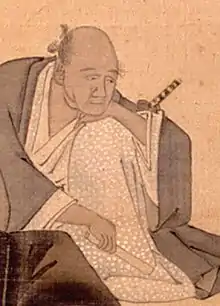
Uejima Onitsura (上島 鬼貫, April 1661 – 2 August 1738[1]) was a Japanese haiku poet of the Edo period. Prominent in Osaka and belonging to the Danrin school of Japanese poetry,[2] Uejima is credited, along with other Edo period poets, of helping to define and exemplify Bashō's style of poetry.
Biography
Born to a family of brewers in Itami (present-day Hyōgo Prefecture), Uejima showed exceptional talent in poetry at the age of eight.
At the age of 25, Uejima moved to Osaka, where he began his professional career in haiku and other forms of poetry.[3]
In later life he worked as a masseur, before becoming a priest.[4]
Hitorigoto
In his meditation on the art of haiku, Hotorigoto, Onitsura maintained that the best way to learn to write haiku was to first imitate one's teacher, and then to develop one's own style.[5]
He also considered makoto or sincerity to be the key to humanity, and to the humane writing of poetry;[6] and urged the application of the best principles of classic Japanese poetry to haiku, so as to ensure its artistic quality.[7]
Legacy
Unlike Bashō, Uejima had few direct disciples.[8] However he continued to have a broad influence upon the writing of haiku, one exponent opposing him to his own actual teacher, Ryōta:
“Onitsura said, ‘Face it that way.’ Ryōta said, ‘Face it this way.’ Oh, what can I do....”.[9]
See also
- Ikenishi Gonsui
- Robert Frost
- Saigyō
References
- ↑ "上島, 鬼貫, 1661–1738". 国立国会図書館典拠データ検索・提供サービスヘルプ. 国立国会図書館のサービス. Retrieved 15 January 2016.
- ↑ Hakutani, Yoshinobu (2009). Haiku and modernist poetics (1st ed.). New York: Palgrave Macmillan. ISBN 978-0230616554.
- ↑ "俳人・上島鬼貫(うえしまおにつら)". 伊丹市の紹介. Retrieved 15 January 2016.
- ↑ R H Blyth, A History of Haiku Vol I (Tokyo 1980) p. 97
- ↑ R H Blyth, A History of Haiku Vol I (Tokyo 1980) p. 96
- ↑ R H Blyth, A History of Haiku Vol I (Tokyo 1980) p. 97
- ↑ Crowley, Cheryl. “Putting Makoto Into Practice. Onitsura's Hitorigoto.” Monumenta Nipponica, vol. 50, no. 1, 1995, pp. 1–46. JSTOR, www.jstor.org/stable/2385278. Accessed 28 Aug. 2021 p. 12
- ↑ R H Blyth, A History of Haiku Vol I (Tokyo 1980) p.104
- ↑ L Zolbrod, Haiku Painting (Tokyo 1982) p. 40